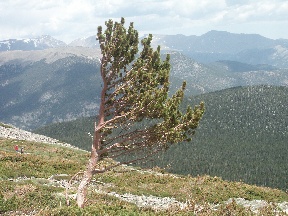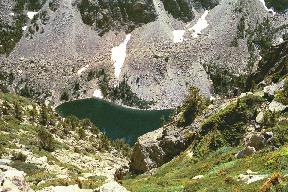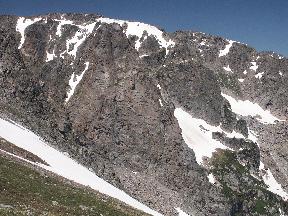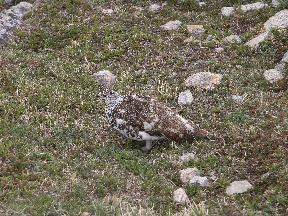










Flattop. It doesn't carry an image of excitement like Everest, K2, or even Longs Peak. Nevertheless, Flattop is a worthy hike: it has good scenery, has many opportunities to view wildlife, makes a good training hike (12,324'), and serves as a start for climbing many more serious peaks. It has a good trail and makes a good family hike.
The trail to Flattop begins at Bear Lake; turn right at Bear Lake and right again at the sign to Flattop. The trail immediately heads up at a fairly steep grade: this isn't the trail to Dream Lake, which we'll be looking down on soon enough. About .4 mile from the trailhead, the Flattop trail branches off to the left and heads up the side of a ridge, again at a fairly steep grade. After a while it moderates, and .4 mile from the last junction there is another trail junction with a turn to the left toward Flattop.
| The trail now heads into thick forest and makes several large switchbacks as it heads up the east flank of Flattop. These woods are a good place to see large birds, including grouse; once I even saw a chicken. About an hour from trailhead is a viewpoint above Dream Lake and a good first rest stop. Chipmunks will be there to try to beg a few peanuts. |  |
| The trail continues upward with large switchbacks as it approaches timberline. Look east for a fine view of Bierstadt Lake; it's pretty unusual to see a lake on top of a ridge like this. |  |
| As the trail rises above timberline, look for Limber Pine banner trees that have been so beaten by fierce winds that branches can only survive on the downwind side. |  |
| Above timberline, you can see where you're going; the next destination is a corner up at the left, the Emerald Lake viewpoint. It doesn't look far, but it will take some time to get there. About two hours from the start, you reach the Emerald Lake viewpoint and another good rest stop. Look for pikas scampering among the rocks; once I saw a tame pika here that would come close enough to see it well. |  |
| The trail now makes a broad arc north and then westward toward the summit. Soon you can see the summit in the distance. |  |
| To the right is the east face of Notchtop. If you want more excitement, the Spiral Route winds around this face and provides 700 feet of vertical exposure. |  |
| Look and listen for pikas and marmots as the trail crosses a tundra slope with food to support them. The trail turns left and approaches a horse rack, very close to the summit. Early in season, there will be a snowfield to cross; the snow is not too steep, but be sure to keep right and away from the corniced edge at left. You reach the summit at about three hours from the start. |  |
| As expected, the summit is flat. It's hard to tell where the highest point is. Hallett Peak now looks like a gentle, rounded mountain. If you still have energy, it only takes another half hour or so to climb it; then you can show your friends a picture of the steep cliff face of Hallett seen from Bear Lake and say that is the mountain you climbed. |  |
| A fine mountain that can't be seen from the road is Snowdrift Peak, due west of Flattop and often snowy. In fact, Flattop is a starting point for climbing many other mountains along the Continental Divide: Hallett, Otis, Taylor, and Powell to the south, Snowdrift, Sprague, and Stones Peak to the north, and others. It is possible to traverse from here all the way to Trail Ridge Road at Milner Pass. If you go a bit farther to the west on Flattop, it is possible to see all the way to Grand Lake, and there are two hiking routes to Grand Lake from here. |  |
| As you head back, be sure to stay alert for the abundant wildlife. The Pika makes a high-pitched, metallic little bark to warn of intruders; it is very adept at running into rock crevices, making it hard for predators to catch. Pikas are active all year. In the summer, they cut grass and make little hay piles under the rocks to sustain them through the winter. |  |
| Ptarmigan stay camouflaged: white in winter, mottled brown that looks like a granite rock in summer. This makes them hard to spot unless they move, but if you look you may see some. They act a lot like chickens, pecking the ground, and have similar looking chicks that follow the mother around. |  |
Time up: 3:00. Time to return: 2:00. Water consumed: 1 qt per adult.